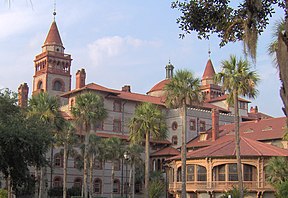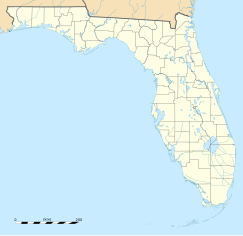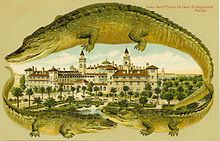Ponce de León Hotel
| Ponce de León Hotel | ||
|---|---|---|
| National Register of Historic Places | ||
| National Historic Landmark | ||
|
The former hotel and now Flagler College |
||
|
|
||
| location | 74 King Street, St. Augustine , Florida , United States | |
| Coordinates | 29 ° 53 '32 " N , 81 ° 18' 54" W | |
| Built | 1885-1887 | |
| architect | Carrère and Hastings | |
| Architectural style | Spanish Colonial Revival with elements of oriental architecture | |
| NRHP number | 75002067 | |
| Data | ||
| The NRHP added | May 6, 1975 | |
| Declared as an NHL | February 17, 2006 | |
The Ponce de León Hotel was an exclusive hotel in St. Augustine in the state of Florida in the United States . It was designed in the style of the Spanish Renaissance by the New York architecture firm Carrère and Hastings on behalf of the millionaire and co-founder of the Standard Oil Company Henry Morrison Flagler and completed in 1888. It consists entirely of cast concrete , with locally occurring Schill limestone being used as an admixture. The hotel was electrified right from the start and was powered by generators provided by Flagler's friend Thomas Alva Edison . Today the property and the building belong to Flagler College .
design
The Ponce de León Hotel was built on a plot of land with orange trees and partly salt marshes . It belonged to medic Andrew Anderson , who also owned the Markland house . Located at 74 King Street in the Spanish Quarter of St. Augustine, the hotel was designed in the Spanish Renaissance style by architects John Carrère and Thomas Hastings who directed Carrère and Hastings architectural firm in New York City . Construction began in 1885 and was completed two years later.
The design of some elements of the interior is attributed to Louis Comfort Tiffany , while Pottier and Stymus were responsible for the furniture. Bernard Maybeck , whose later designs include the Palace of Fine Arts in San Francisco , served the project as a technical draftsman. The architect Emmanuel Louis Masqueray , who had only recently arrived from Paris, was hired as the lead architect of the 1904 World Exhibition in St. Louis and made ink drawings of the hotel.
Muralisms were made in the rotunda and in the dining room by the artist George W. Maynard , who around ten years later created the murals in the Treasures Gallery in the Thomas Jefferson Building of the Library of Congress . The Italian artist Virgilio Tojetti was responsible for the ceiling paintings in the large salon .
Originally, the twin towers of the hotel served the purpose of water tanks, each with a capacity of 8000 gallons (approx. 36 m³ ), which provided the hotel guests with running water. During World War II , one of the towers was used as a prison during the US Coast Guard occupation .
The building was one of the first of its size in the United States to be cast in concrete on site, and it was also one of the first to have electricity. Flagler owes this fact in particular to the fact that the finance director of the Edison Electric Company was a brother of the executive architect Thomas Hastings .
Hotel operations
Frank Thompson was the hotel's head waiter in the 1880s and 1890s . He was one of the first civil rights attorneys in the United States and formed the Cuban Giants professional baseball team , which consisted entirely of African American players. One member of the team was Frank Grant , who was later inducted into the Baseball Hall of Fame .
Many famous people stayed at the hotel, including Mark Twain , Theodore Roosevelt , Somerset Maugham , Babe Ruth and Babe Didrikson . It was one of the few of Flagler's hotels to survive the Great Depression . Subsequent programs of the US federal government to revive tourism drew writers such as Ernest Hemingway , Zora Neale Hurston , Robert Frost , John Dos Passos and in particular Marjorie Kinnan Rawlings to St. Augustine, who lived there temporarily or permanently. This community became widely known as the "Lost Colony", whose works are now highly collectible.
The hotel also had a few studios that attracted many American artists such as Martin Johnson Heade , who created the painting Giant Magnolias on a Blue Velvet Cloth in Studio No. 7, among others . It now hangs in the National Gallery of Art in Washington, DC Heade himself was honored, among other things, with an American postage stamp showing his portrait. More of his works hang in the White House and major art galleries .
Training center in World War II
During the Second World War , the hotel was used as a training camp for the US Coast Guard , which is why St. Augustine is often viewed as the birthplace of the Coast Guard reservists. One of the first classes for reserve officers completed their training in May 1941 in the converted Ponce de León Hotel . From 1942 to 1945 several thousand more graduates followed what was probably the most unusual training facility of the Second World War. On the occasion of its 50th anniversary, members of the Coast Guard Reserve met at the former hotel in the 1990s to celebrate this anniversary.
One of the graduates was Jacob Lawrence , who was already a well-known artist at the time. In 1944 he was transferred to the Sea Cloud , the first ship in the US Navy on which African Americans were allowed to serve. Lawrence continued his artistic work and was the first black painter whose works were hung in the Vatican and the White House. He never forgot the racism he was exposed to in St. Augustine.
Hotel and college business after the war
In 1963 the hotel was one of several locations for the civil rights movement in St. Augustine. Then- Vice President Lyndon B. Johnson was invited to attend a banquet to celebrate the city's 400th anniversary, making it the oldest continuously inhabited European settlement in the United States. Robert Hayling and other civil rights activists protested the exclusion of African Americans from the ceremony, and after lengthy negotiations, two more tables for African American residents of the city were added off the other tables.
In 1964, nationally noted demonstrations took place in the city, to which Martin Luther King also became aware. On March 31, 1964, more than 100 students from the all-African American Richard J. Murray High School marched into the city center and occupied the dining room of the Ponce de León Hotel . There they were overpowered and arrested by policemen armed with dogs and batons. This was the civil rights movement's first mass occupation in St. Augustine and was picked up in an article in the New York Times the following day . Other incidents followed, each contributing to the passage of the Civil Rights Act of 1964 .
In 1968 the hotel became the centerpiece of the newly established Flagler College . Starting in 1976, the college began an ambitious campaign to restore the hotel and other campus buildings from the Flagler era. In 1988 the college celebrated the 100th anniversary of its main building. Ten years later, students at the facility launched the Flagler's Legacy Program, which offers guided tours of the former hotel to several thousand visitors annually. It was added to the National Register of Historic Places on May 6, 1975 as a monument . The Ponce de León Hotel became a National Historic Landmark on February 17, 2006 .
literature
- Thomas Graham: Flagler's St. Augustine hotels . the Ponce de Leon, the Alcazar, and the Casa Monica. Pineapple Press, Sarasota, Fla. 2004, ISBN 978-1-56164-300-4 .
- Edward N. Akin: Flagler, Rockefeller partner and Florida baron . Kent State University Press, Kent, Ohio 1988, ISBN 978-0-87338-348-6 .
- Laurie Ossman, Heather P. Ewing, Steven Brooke: Carrère & Hastings: the masterworks . Distributed to the US Trade by Random House, New York: Rizzoli 2011, ISBN 978-0-8478-3564-5 .
Individual evidence
- ↑ a b Hotel Ponce de León. National Park Service , accessed September 4, 2012 .
- ^ Alan K. Lathrop: A French architect in Minnesota: Emmanuel L. Masqueray, 1861-1917 . In: Minnesota history (= Minnesota profiles ). tape 47 , no. 2 , 1980, OCLC 46595487 , pp. 42-56 .
- ↑ Robert Wilson Torchia: Lost colony: the artists of St. Augustine, 1930-1950 . Lightner Museum, St. Augustine 2001, ISBN 978-0-9713560-0-9 .
- ^ David R. Colburn: Racial change and community crisis . St. Augustine, Florida, 1877-1980. Columbia University Press, New York 1985, ISBN 978-0-231-06046-2 .
- ^ Taylor Branch: Pillar of Fire . America in the King years, 1963-65. Simon & Schuster, New York 1998, ISBN 978-0-684-80819-2 .
- ^ Hotel Ponce De Leon in the National Register Information System. National Park Service , accessed August 7, 2017.
- ↑ Listing of National Historic Landmarks by State: Florida. National Park Service , accessed July 20, 2019.



